The Cell's Complex Structure Can not Be Explained in Terms of Coincidence
To describe the cell's complex structure and the processes requiring information and planning that it carries out, many scientists resort to analogies. Some compare cells to specially designed spaceships, others to highly developed city centers, and still others to laboratory environments at a far higher technological level than those known today. Yet following such comparisons, they always state that the cell is actually far, far more complex.
 |
|
With all the amazingly complex, mutually-dependent components, it seems that the cell had to be complete from the beginning ... Dr. David Rosevear
|
W. Thorpe, a Cambridge University professor of zoology, refers to the complexity of the cell in these terms:
I think it is fair to say that all the facile speculations and discussions published during the last 10 to 15 years explaining the mode of origin of life have been shown to be far too simple-minded and to bear very little weight. The problem in fact seems as far from a solution as it ever was. The origin of even the simplest cell poses a problem hardly less difficult. The most elementary type of cell constitutes a mechanism unimaginably more complex than any machine yet thought up, let alone constructed by man. There is no real clue as to the way in which any of these riddles were solved . . . 7
 |
|
The theory of evolution alleges that life began from a so-called simple cell and developed gradually. Yet current science shows that there is no such thing as a simple cell. Dozens of books have been written about the cilia—thin hairs on the cell surface—alone, and scientists have researched them for years.
|
The accounts given by Darwinists regarding the beginning of life refer only to an allegedly very simple cell that came into being by coincidence and that gradually acquired its present-day characteristics—again by coincidence. Yet these illogical claims lead them into serious inconsistencies. For example, the cell possesses features that it cannot survive without. Moreover, the cell cannot wait to evolve these complex characteristics. Therefore, it's not possible for the cell to have ever been "primitive", as Darwinists so fondly imagine, nor to have evolved by stages. Indeed, today's Darwinists have had to admit that there was no such developmental process in the cell's formation. The evolutionist biologist Hoimar von Ditfurth admits this:
When we look back, we see that we need not be surprised that we have been unable to find those transitional forms so almost painfully sought. Because in all likelihood, no such intermediate stage ever happened. What we know today shows that the general principle of the universe is not a reality here, and that it is out of the question for the primitive cell to have developed in stages and to have eventually turned into a cell with a nucleus and organelles. 8
The cell can perform its functions only if all its elements and attributes exist, fully formed. Professor David Rosevear, a member of the British Royal Chemistry Society refers to the cell functioning when it exists as a whole:
With the development of molecular biology since the time of Oparin and Haldane, the cell is no longer regarded as simple. The living plasma membrane allows in or out only specific compounds. It is not simply a semi-permeable membrane. Cells contain nucleic acids that carry information about the structure and functions of the organism. They also contain ribosomes where proteins are made using a complex mechanism of nucleic acids and more than a hundred different proteins, each with a specific task. The cell also contains mitochondria where energy (ATP) is produced. The complexity of all these parts of the cell is enormous ... However, these components cannot now exist independently, nor could the cell exist without their contributions ... With all the amazingly complex, mutually-dependent components, it seems that the cell had to be complete from the beginning, rather than being assembled piecemeal over years of evolution. 9
To survive, one feature the cell needs to possess is the ability to recognize danger. Even if we assumed the existence of a cell lacking such ability, it would still be unable to survive. This difficulty is referred to in one Darwinist source:
Ever since the first moment they came into being, living systems must have been equipped with the ability to distinguish the various features of their habitat and environment from one another. Living things have been able to demonstrate an inescapable ability to survive during material assimilation, to be able to recognize and distinguish the environmental factors on which they depend, to survive to the extent that and for as long as they possess the ability to learn and possess these abilities, and the ability to stay alive. They had to be able to determine which of these environmental factors [for example, energy providing large molecules such as sugar and protein] are beneficial for them and which are dangerous or harmful, because these harmful agents in question have a "toxic" effect that blocks and derails the cell's material assimilation processes. This is of course a superstitious belief. 10
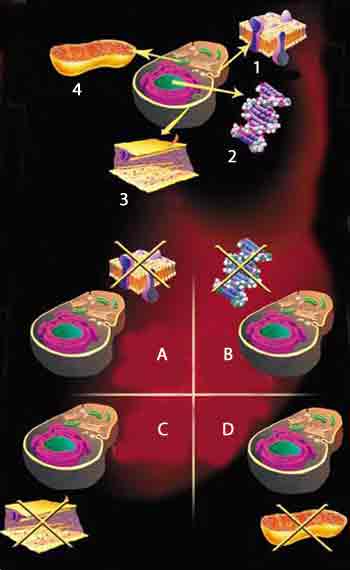 |
The Cell can Function Only When all its Components are Present and Fully Formed
|
|
1. Cell membrane
2. DNA
3. Cell skeleton
4. Mitochondria
|
|
A. There can be no cell in the absence of the CELL MEMBRANE.
B. There can be no cell in the absence of DNA.
C. There can be no cell in the absence of the CELL SKELETON.
D. There can be no cell in the absence of MITOCHONDRIA.
|
As you have seen, a cell can remain alive only so long as it can distinguish between what is beneficial and what is harmful to it. The above quotation refers to abilities of the cell such as selection, differentiation, distinguishing, learning and sorting. Darwinists—who expect unconscious cells to acquire by coincidence these actions that require thought, reasoning and awareness—deliberately ignore this illogical position. They imagine that coincidences will somehow resolve all inconsistencies. They regard coincidence as a potent force that opens all doors, overcomes all difficulties and plans everything right down to the finest detail. This is indeed a superstitious belief!
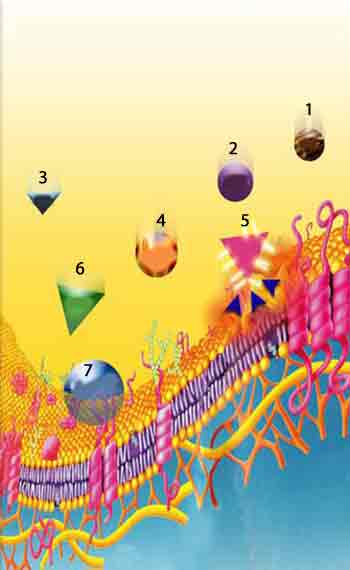 |
1. Iron
2. Sodium
3. Glucose
4. Potassium
5. Carbon
6. Protein
7. Water Molecule
|
|
The cell membrane's selective permeability is of vital importance. Water molecules that the body constantly needs pass easily through the cell membrane, but hormones cannot enter unless they are recognized by receptors on the membrane. There is a sensitive plan and order in the selection of substances to be absorbed. That order belongs to Omniscient Allah, Who is most worthy of praise.
|
In the face of the superior intellect in the cell, many issues leave Darwinists in a quandary. For example, how did coincidental accumulations of unconscious atoms bring into being a cell with exceedingly conscious processes? Darwinists maintain that the cell emerged as a result of chemical reactions that took place of their own accord in nature. Yet every detail in the cell is part of a specific plan and order. Every detail reveals the existence of a superior Creator.
Fred Hoyle, the well-known British scientist, examined this question in detail:
If there were a basic principle of matter which somehow drove organic systems toward life, its existence should easily be demonstrable in the laboratory. One could, for instance, take a swimming pool to represent the primordial soup. Fill it with any chemicals of non-biological nature you please. Pump any gases over it, or through it, you please, and shine any kind of radiation on it that takes your fancy. Let the experiment proceed for a year and see how many of those 2,000 enzymes (proteins produced by living cells) have appeared in the bath. I will give the answer, and so save the time and trouble and expense of actually doing the experiment. You would find nothing at all, except possibly for a tarry sludge composed of amino acids and other simple organic chemicals. 11
One evolutionist writer makes the following admission:
The popular conception of primitive cells as the starting point for the origin of the species is really erroneous. There was nothing functionally primitive about such cells. They contained basically the same biochemical equipment as do their modern counterparts. "How, then, did the precursor cell arise?" The only unequivocal rejoinder to this question is that we do not know.12
The researcher and writer Howard Peth states that there is no such thing as a simple cell:
Formerly, it was thought that a cell was composed of nucleus and a few other parts in a sea of cytoplasm, with large spaces in the cell unoccupied. Now it is known that a cell literally swarms—that is, it's packed full of important functioning units necessary to the life of the cell and the body containing it. The theory of evolution assumes life developed from a simple cell. But science today demonstrates that there is no such thing as a simple cell. 13
 |
There is No Room For Coincidence in The Origin of Life
|
|
If you placed all the components of life—amino acids, proteins, lipids, carbon, phosphorus, calcium, and carotene—into a huge vat and then heated it, froze it, subjected it to lightning, passed electric currents through it and brought in any advanced technological equipment you liked and performed any processes you wished, not a single cell would emerge from that mixture. Even if you continued the experiment for billions of years, no cell, the product of Creation, will ever emerge.
|
No doubt Darwinists who emerged under the banner of science never imagined that science would one day invalidate their claims. In the 1800s, when there were no electron microscopes; when the science of genetics did not yet exist, no one realized the complex structure of the cell. Therefore, that life was the work of coincidences was a claim based on ignorance, able to deceive people for a time. Today, however, science and technology have shown that the cell actually possesses an exceptionally complex structure, so much so that despite all scientists' best endeavors and the advanced means at their disposal, they have been unable to create any structure like the cell.
People of intelligence and reason expecting the cell, which cannot be replicated by artificial means and technologies, to be the work of coincidence is a clear nonsense. In the face of this impasse, Darwinists hide behind the concept of "changes over time," maintaining that such changes are actually possible over millions of years. Yet no matter how much time is given, expecting a structure that possesses information, contains a particular order, and exhibits intelligent, purposeful behavior to develop by coincidence is only imagination. Time has no power to create an perfect order, nor to eliminate different coincidences by means of trial and error, nor to make decisions.
The biologist Professor Michael Pitman, who served with the Australian Academy of Science, describes how the effects of time will be the exact opposite of what Darwinists expect:
Time is no help. Bio-molecules outside a living system tend to degrade with time, not build up. In most cases, a few days is all they would last. Time decomposes complex systems. If a large word (a protein) or even a paragraph is generated by chance, time will operate to degrade it. The more time you allow, the less chance there is that fragmentary sense will survive the chemical maelstrom of matter. 14
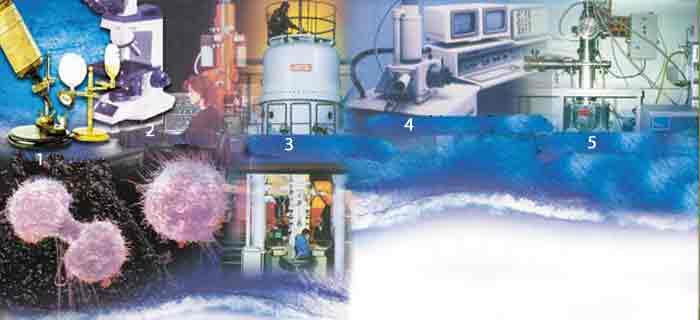 |
|
1. Early microscope
2. Light microscope
|
3. Electron microscope
4. Scanning electron microscope
|
5. Ion microscope |
|
Until the 20th century, it was assumed—given the early state of scientific knowledge—that living things had very simple structures and that inanimate substances could randomly come together and form a living cell. However, the 20th and 21st centuries saw a turning point in the history of science. Once the complex structure of the cell was discovered, it was realized that coincidence had no place in the origin of life.
|
Ceaseless Activity within the Cell
A living cell is a marvel of Creation that astounds all scientists. Examined under an electron microscope, the cell can be seen to contain activity reminiscent of a beehive's. In the same way that life in the hive goes on even as hundreds of bees die and new ones take their place, millions of cells in the human body die every day, and are again replaced by new ones. And billions of cells work together in harmony to keep the body alive.
Each of those 100 trillion cells functions like a walled city. Power plants generate the cell's energy. Factories produce proteins, vital units of chemical commerce. Complex transportation systems guide specific chemicals from point to point within the cell and beyond. Sentries at the barricades control the export and important markets, and monitor the outside world for signs of danger. Disciplined biological armies stand ready to grapple with invaders. A centralized genetic government maintains order. 15
 |
If There is a Creation Anywhere, There Must also Be a Creator
|
|
Imagine an impressive building by the side of the road… Would you say "Coincidence has created something really perfect here"? Nothing so illogical would ever enter your mind. You might well think how carefully the architect had drawn up the building, how flawlessly engineers had planned it, how many details the designers thought of to make it user friendly. In the same way, the knowledge, intellect and might of our Lord can be seen in the cell, created by Him.
|
The intracellular transport system is also quite complex. Plant and animal cells are divided into many discrete compartments; supplies, including enzymes and proteins, must be shipped between these compartments. Some supplies are packaged into molecular trucks, and each truck has a key that will fit only the lock of its particular cellular destination. Other proteins act as loading docks, opening the truck and letting the contents into the destination compartment. 16
 |
|
Inside the cell there are power stations that provide the cell with energy, factories that produce proteins and vitally important chemicals, complex transportation systems that carry these into and out of the cell, and sentries to maintain security. This complex structure, here summarized in just a few words, runs with a far more perfect order than any major city.
|
The molecules within the cell operate at an astonishing speed. Their organized and coordinated functions are of a complexity that defies description.
Despite being a confirmed atheist and who therefore sought to account for the origin of the cell in terms of coincidence, the American astronomer and biologist Carl Sagan referred to the activities in the cell:
A living cell is a marvel of detailed and complex architecture. Seen through a microscope, there is an appearance of almost frantic activity. On a deeper level it is known that molecules are being synthesized at an enormous rate. 17
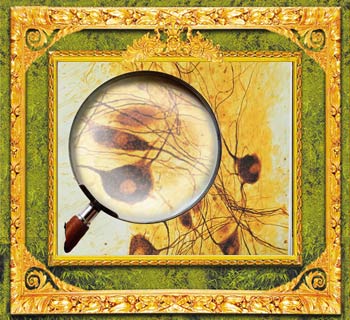 |
|
For people possessed of reason, the presence of a highly complex electrical system in nerve cells too small to be seen with the naked eye is one of the proofs of Allah's infinite wisdom.
|
Michael Behe, a famous professor of biochemistry from Lehigh University and one of the most prominent contemporary critics of Darwinism, has stated that everything inside the cell contains far more complex structures than it would appear:
I believe that Darwin's mechanism for evolution doesn't explain much of what is seen under a microscope. Cells are simply too complex to have evolved randomly; intelligence was required to produce them. Darwin's theory encounters its greatest difficulties when it comes to explaining the development of the cell. Many cellular systems are what I term "irreducibly complex." That means the system needs several components before it can work properly ... Such a system probably cannot be put together in a Darwinian manner, gradually improving its function. 18
The cell's "irreducible complexity" presupposes that a great many components need to be present and fully formed in order for the system to work. That being so, coincidences would need to bring all the components of the system into being in a conscious manner, capable of performing functions requiring intelligence, data and order, in a single action. Yet because all the parts constituting the system are exceptionally complex, there can be no progression from simple to complex. These components can exist only when they are all present together.
That the cell—the fundamental building block of life—has such a complex structure is one of the main reasons why Darwinists cannot answer the question of how life could have begun by coincidence. This complexity is at such a high level that it cannot be explained in terms of coincidence.
Michael Behe describes this impasse faced by Darwinist scientists with a quotation from the evolutionist James Shapiro:
The bottom line is that the cell—the very basis of life—is staggeringly complex. But doesn't science already have answers, or partial answers, for how these systems originated? No. As James Shapiro, a biochemist at the University of Chicago, wrote, "There are no detailed Darwinian accounts for the evolution of any fundamental biochemical or cellular system, only a variety of wishful speculations." A few scientists have suggested non-Darwinian theories to account for the cell, but I don't find them persuasive. Instead, I think that the complex systems were designed—purposely arranged by an intelligent agent. 19
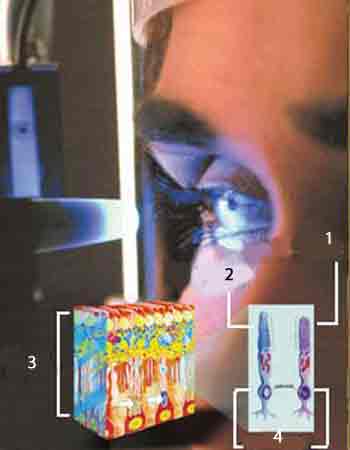 |
1. Rod cell
2. Cone cell
3. Retina
4. Nucleus
|
|
The eye's retinal cells have been specially created to be sensitive to light. When photons strike these cells, they set one another in motion, like dominos stacked up in a row. This causes various proteins to change form and for new attachments to take place among them. Following a chain of chemical reactions, electrical stimuli are generated. Nerves transmit these to the brain, where the process we refer to as vision takes place. This bright world you see in all its details is a great blessing imparted by our Lord, by means of the flawless structure of your retinal cells.
|
Professor Gerald Schroeder, who works at MIT in the fields of physics and biology, describes the complexity of the cell with an analogy:
Going inside the body and then inside the cell is a journey to wonderland. Enclosed by its outer membrane, a cell's functions are walled off from the outside. When we look at any structure from outside, we get a highly simplified version of its essence. We decide to pick up a pencil and then do so. Not much to do it. But in the path leading from the thought to the act, millions of cells and millions of atoms acting on command were required to accomplish that mundane feat. From the outside, it seems so straightforward like starting a car: Just turn the key. Or a computer: Just press the power button. A myriad of hours were required to design the circuits and invent the components so that one simple act will activate the billions upon billions of atoms in just the right sequence needed to ignite the motor or light the screen. 20
 |
|
Almost any system appears simple when viewed from the outside. For example, it's enough to turn the ignition key to start your car's engine running. Yet for that to happen, thousands of components have been produced and brought together within a specific plan. A great many people have spent their time, energy, knowledge, and experience, to bring this about. You do not even have to turn a key for the systems in your body to work. Whether at the cell, organ or system level, it functions without your intervening in any way. All this is a manifestation of our Lord, the Compassionate and Merciful.
|
For a long time, Darwin and the Darwinist biologists who followed him looked at the cell only from the outside, which is why they regarded it as a simple structure and imagined they could account for its origins in terms of coincidence. In the second half of the 20th century, however, as the extraordinary complexity of the cell became increasingly clear, Darwinists found themselves astonished and despairing. Nowadays, they only hope that the origin of the cell will one day be explained by evolutionary mechanisms. They have no evidence, merely that faint hope, which is solely based on their dogmatism on the subject.
The complexity that emerges in the cell proves that there was Creation here. Moreover, however, an astonishing intelligence is on display. No doubt that cells are devoid of such abilities as intelligent thought, learning, decision-making or planning. When we examine the processes they perform, however, we see that cells work in a more far-sighted, rational and precautionary, careful and scrupulous manner than even the most intelligent humans.
This superior intellect displayed in the cell is that of our Lord:
He created everything and determined it most exactly. (Surat al-Furqan, 2)
The Cell Cannot Exist Without the Cell Membrane
Before examining the cell membrane's structure and its selective permeability, it will be instructive to touch on Darwinist views on this subject. We have already detailed in earlier books how truly unscientific and unrealistic is the Darwinist claim that the first cell formed spontaneously as the result of coincidences. (For details, see Harun Yahya, Darwinism Refuted, and The Evolution Deceit.) But let's ignore all the impossibilities and assume that some organelles of the first cell actually did come into being spontaneously. In that event, the Darwinists' position becomes even more problematic. The first candidate cell would have to acquire, coincidentally, a cell membrane in order to survive—especially in a primordial environment, where atmospheric conditions are known to have been harmful.
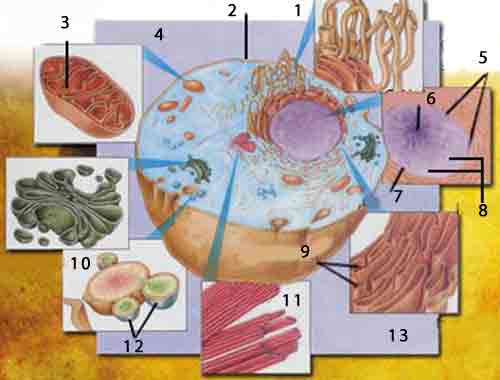 |
1. Smooth endoplasmic reticulum
2. Cell membrane
3. Mitochondrial undulations
4. Mitochondrion
5. Nuclear pores
6. Nucleolus
7. Nuclear envelope
8. Chromatin
9. Ribosomes
10. Golgi apparatus
11. Centriole
12. Lysosomes
13. Granular endoplasmic reticulum
|
|
The cell and its other organelles could not exist without the selectively permeable membrane. The cell needs to possess a membrane to prevent harmful substances entering from the outside, and to nourish by admitting the needed substances.
|
Did a living thing alleged to have come into being by coincidence also take the appropriate precautionary measures by coincidence? No matter how irrational that claim may be, let us again assume that this actually happened and continue with what is no more than conjecture: the first cell, having come into existence by coincidence, disappeared due to an inability to withstand the atmospheric conditions. New cells then emerged—again as the result of coincidence. But these, too, could not survive. The cells that formed later learned from what happened to their forerunners and decided that they should not enter that primordial atmosphere unprotected.
Again with the help of coincidence, by means of trial and error, they acquired an outer shell—in other words, a membrane, with all the necessary characteristics—to protect them from these harsh conditions. But consider: can an unconscious cell with no mind or brain come up with such an effective solution for itself, or can coincidence do so? To explain in terms of coincidence for the cell possessing a membrane to protect it from harmful external substances and to arrange for the requisite nourishing substances to enter is a violation of science. A cell cannot survive for even a short time in the absence of these features, and even the slightest error would have fatal consequences. In addition, this flawless perfection would have to be present not only in the first cell, but would have to be maintained in all those that came after.
Darwinists' explanations regarding the first cell are nothing more than accounts, based entirely on assumptions. The evolutionist biologist Hoimar von Ditfurth offers the following explanation for the cell membrane:
. . . all these early cells were covered with an outer surface membrane, and in that sense, we may refer to a property common to them all, because the precondition of being able to perform material assimilation is to some extent independent of environmental chemical processes and erects a barrier between the organic system and external factors by making the system relatively independent of the environment and conditions around it. In those terms, we have to assume that almost all the early cells were covered in such an external membrane that acted as a barrier. 21
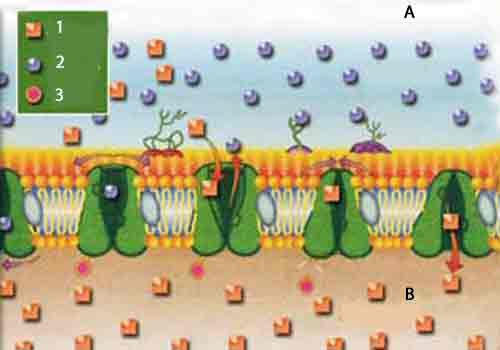 |
A. Extracellular Environment
B. Intracellular Environment
1. Potassium
2. Sodium
3. Phosphorus
|
|
The cell membrane understands that substances like potassium and sodium differ from one another, and employs different methods for these substances' quantities and speeds of passage. Some substances it does not permit to pass. Darwinists assume that the cell membrane's selective permeability could have developed gradually, but this is not possible. If the cell membrane lacked any of the properties it possesses, the cell could not survive.
|
How clearly irrational von Ditfurth's explanation is! It is impossible for a cell that came into being by coincidence to reason that it needs an enclosure and then to immediately manage to implement one. Such an event may happen in science fiction films, but to claim that each one of a great number of cells came about by coincidence and displayed the same intellect is an irrational and far-fetched claim.
In conclusion, the cell's very existence requires the existence of its cell membrane. And it is impossible for that membrane to come into existence through the cell's own decision or by any string of coincidences. Professor Gerald Weissman of the New York University Medical Center has emphasized the essential nature of the cell membrane in order to be able to speak of life:
In the beginning, there must have been a membrane! Whatever flash of lightning there was that organized purines, pyrimidines, and amino acids into macromolecules capable of reproducing themselves. 22
Scientists agree that it is impossible to speak of life in the absence of the cell membrane. However, do not forget that the cell membrane also must exist with its present-day complex structure and characteristic of selective permeability. It is out of the question for that feature to develop by stages, as Darwinists hypothesize. If the cell membrane does not possess its present features, then the cell itself cannot survive. The cell membrane must therefore be able to know the external environment, identify the cell's needs, determine whether substances about to enter the cell are harmful, and make no errors in these selections. Clearly chemical reactions, the laws of physics and coincidence cannot endow this thin membrane—consisting of inert fats and proteins, with such conscious selectivity.
|













